Lakes and ponds are good fun for recreational use and are an integral part of many agricultural operations. They can also enhance the aesthetic nature of parks and act as the centerpiece for attractions. But without proper maintenance, the water can form a buildup of sediment, vegetation and trash, leaving your water source smelling rank and looking unpleasant.
GeoForm International Inc. can help you maintain your lake or pond to keep it healthy and useable — for both humans and nature. Maintenance requires the right pond and lake equipment, whether you’re removing aquatic vegetation, aerating the pond or skimming the lake’s surface.
Types of Pond and Lake Maintenance Equipment
Jump To: Dredges | Aerators | Excavators | Weed Harvesters | Aquatic Skimmers | Lake Rakes | De-Icers
Pond maintenance is crucial if you want to enhance the water’s aesthetic while also preserving its various ecological components. Lakes, ponds and other bodies of water are integral parts of many ecosystems. They inhabit a range of aquatic plants and animals and provide a source of food and water for land-dwelling species.
So, when your farm pond, recreational lake or wildlife area becomes stagnant or contaminated, there are a few ways you can maintain it. A wide range of tools is typically used to maintain ponds and lakes, including the 7 mentioned below.
1. Dredges
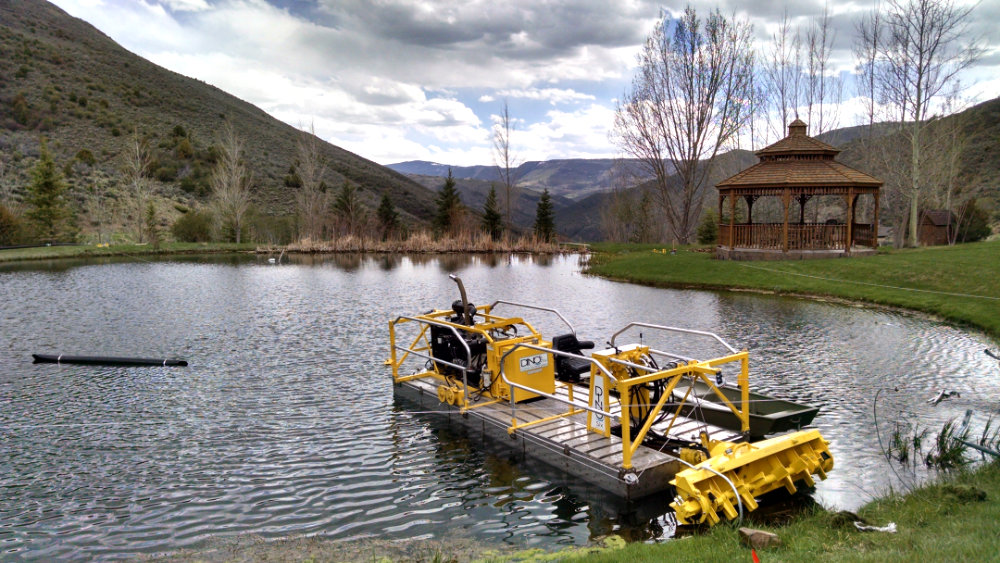
Dredges are machines that remove built-up sediment from the bottom, sides or banks of your lake or pond. Sedimentation is the process in which soil particles erode and deposit a layer on the bottom of a body of water. It can cause many issues in your pond or lake over time, such as water depth reduction.
Sedimentation can also prevent boats and other machines from passing over the water. The buildup can even result in water contamination that poses a threat to wildlife and aquatic plants, forming environmental hazards. When you need a solution to remove a massive accumulation of sediment while preserving the health of your water source, dredging is a common solution.
Dredging removes sediment, then transports it to another location for other purposes. The machine creates a vacuum that sucks up the debris and sediment, then pumps it out. Numerous dredges are manufactured for small areas like ponds and lakes that can be partially or fully emerged in the water. Different types include plain, cutter and auger suction or jet-lift dredges.
Each requires a different power source and has different ways of getting the muck from the bottom of the pond or lake. Muck can reduce oxygen levels of the water, causing a foul odor. With lower oxygen levels, your pond or lake has a lower chance of supporting wildlife
Dredges for ponds and lakes are usually portable machines that can get into tight spaces, whereas large dredges for ocean dredging can’t operate efficiently on ponds or lakes.
Dredges provide many benefits, such as:
- Forging a healthier ecosystem
- Keeping invasive vegetation from growing
- Making ponds and lakes deeper
- Removing stagnant muck
Because ponds and lakes are inactive bodies of water, dredges are ideal solutions to remove the sediment buildup and create a healthier body of water. If you’re looking to learn more about when to dredge a pond, click here.
2. Aerators
Aeration systems increase and stabilize oxygen levels in your pond or lake. Aerators move the water and break the liquid’s surface to help it come in contact with the air. Some natural sources of aeration include heavy rain and wind, but if the natural elements are not consistent, you can rely on mechanical ventilation to get the job done.
Different aeration systems include:
- Diffused or deluxe
- Garden pond
- High-oxygen surface
- Shallow pond
- Solar-powered
- Windmill
The purpose of an aerator is to eliminate thermocline. Thermocline is when the water’s surface is colder and more oxygen-deprived compared to the deeper and warmer water levels that are oxygen-rich. The split between the surface and deeper water is called stratification. Aeration helps to circulate the water to eradicate the divided temperature changes.
Without proper ventilation, the aerobic bacteria on the lake or pond’s floor won’t receive oxygen. If the bacteria isn’t receiving oxygen, it won’t be able to break down the organic material that falls from the oxygen-rich layers above. As a result, rotting organic material forms — also known as muck.
Muck will cause excessive algae growth, which can be the reason for unhealthy fish, floating plants and swarms of insects like mosquitos.
The aeration process infuses oxygen into your lake or pond, benefiting the fish and other wildlife that live in the water. Aerating your lake or pond also:
- Boosts water quality
- Improves ecosystem health
- Reduces muck
- Eradicates stagnant smell
- Keeps invasive vegetation from growing
3. Excavators
Although excavators are often seen on construction sites, they can support a multitude of applications, including pond and lake maintenance.
Excavators are pieces of heavy machinery made for excavating or digging trenches, foundations and holes. Depending on the size of your lake or pond, you may need a standard excavator, which is the perfect size for heavy and tough jobs. Other models you can choose are midi and mini.
Brands that offer heavy equipment excavators range from Caterpillar, John Deere and Volvo to Case, Komatsu and JCB.
For water maintenance, you can equip an excavator with attachments like buckets, grabs and rakes to take out the physical labor of cleaning. You can use an excavator for sediment removal on ponds and lakes to scrape the surface. This process is typically referred to as mechanical dredging.
The machine’s bucket or rake can remove large masses of vegetation, muck, wood and other debris. Investing or renting a long reach excavator will allow you to reach further into the lake or pond to make a clean sweep across the water. It’s an efficient and straightforward way to clear the water’s surface.
You can also use an excavator to construct a pond, lake or another marine construction. Steps to making a pond using an excavator are as follows:
- Design the pond and use marker flags to determine its exact shape.
- Buy or rent the right heavy equipment size and model with the appropriate attachments.
- Select a dumpsite for the dirt.
- Dig the pond in layers — start at the edge and move toward the middle.
No matter your use of an excavator, a tracked machine works well on steep grades because it has a low center of gravity. Its wider footprint gives you more contact with the ground as you work your way around the edge of the water.
Tracked equipment can also maneuver well on softer ground like mud and low levels of water for safe operations. Using a tracked unit gives you more mobility and the freedom to swing in multiple directions around the pond within a single radius.
4. Weed Harvesters
Water management equipment like weed harvesters can help combat the spread of weeds and aquatic vegetation in your lake or pond.
They are similar to dredges but used specifically for aquatic weed removal. Also known as a water mower, the machine is mounted on a pontoon that’s designed for inland water management. The harvester is hydraulically driven to travel through clogged ponds and lakes.
The sizeable floating machine has reciprocating blades underwater located on the harvesting head. The blades cut and harvest different vegetation like reeds, weeds and aquatic plant life that’s causing detriments to your lake or pond. Removing plants from a body of water is called aquatic harvesting.
First, the weeds are cut vertically, then horizontally, to separate the mass. A harvester removes aquatic weeds about two to three meters below the water’s surface. It also removes algae and other forms of debris that’s built up in the system.
Once the weeds and reeds are cut, they move to the conveyor system on the machine’s deck. The conveyor fills over time and stores the biomass, packing it tightly. The vegetation then transfers to your lake or pond’s shoreline or a truck for other uses. If being reused, the plants are pressed to remove any moisture.
Several uses of aquatic weeds include:
- Compost
- Feeding livestock
- Land reclamation
- Organic fertilizer
- Pulp and paper
Removing excessive plant life is beneficial if it’s overtaking your area and negatively affecting the ecology of the water source. Using a weed harvester can improve water quality, too.
View Our Pond and Lake Maintenance Equipment
5. Aquatic Skimmers
Trash and debris can suffocate aquatic plant life, as well as harm animals like fish, newts, frogs, turtles and freshwater muscles. Non-aquatic animals can also suffer from large amounts of trash on the water like birds and small mammals. Rubbish can cause entanglement, and if ingested, it can cause starvation and internal injuries.
If you’re looking to remove trash and debris from the surface of your lake or pond’s surface, using an aquatic skimmer is your go-to. The machine can also collect semi-submerged pollutants. It can pick up plastic, cigarettes, cans, algae, bottles, litter and wood, plus liquid waste like oil, sewage, spilled drinks and other fluids.
An aquatic skimmer is a heavy-duty workboat that uses turbines to pull in a stream of water. A filter collects the waste and debris by vacuuming it out of the water. Once gathered, the equipment moves the contaminants and other toxic pollutants into a storage conveyor and filters the clean water back out. The trash is transported to an off-loading point and discharged for other uses or recycling.
Skimmers are especially helpful in areas that see high traffic from the public, like zoos, parks and family attractions.
Pond cleaning tools like skimmers make ponds and lakes more aesthetic while reducing health risks and increasing ecological conservation.
6. Lake Rakes
Lake rakes are ideal when you need to harvest weeds on a small scale — making them more effective on ponds compared to larger lakes. This option can cost less than $100 so for residential pond or lake cleaning, this is often the route people go to remove weeds.
Using a lake rake is a direct process in which you throw the device into the water and pull it back to shore. The rake’s teeth will cut through weeds and collect muck to help keep the growth of unwanted vegetation to a minimum.
Some factors you may want to consider are pole length, material, buoyancy and teeth.
Depending on the size of your pond, you may need a long-reach rake with a broad head to gain maximum reach. The equipment often comes with long ropes, so you can thrust the rake into the water and easily retrieve it.
You will want a rake made of high-quality materials that have also been treated with specialized finishes to resist corrosion and rust. Commonly used materials consist of aluminum, plastic and steel. It’s important to find one that’s easy to push, pull and throw into the water.
You will also want to consider its buoyancy. Do you need one that sinks to reach the bottom of your pond or one that floats to catch surface weeds and debris? Longer teeth can uproot deeper plants but may stir more sediment. Flat and wide teeth are ideal for covering large surfaces where you need to collect weeds.
Bottom rolling rakes are also available. They use a large revolving drum with teeth to push across the bottom of your pond or lake to dig up and remove unwanted weeds. Rolling rakes are better for sedimentation, while rakes are good for surface maintenance.
7. De-Icers
A de-icer is a piece of equipment that pushes warm water to the surface of your lake or pond to avoid ice buildup.
Generating an ice-free area helps protect your dock, boat or other structures in the water. It also aids in averting ice damage, such as ice expansion and jacking. Ice jacking is when water overtakes the area around a structure, and once it freezes, it causes the assembly to fracture as the ice expands.
A de-icer also supports fish and other aquatic species by allowing oxygen to enter the water through the open areas.
While the de-icing equipment is commonly used during winter, it can also support your lake or pond throughout other seasons. It offers benefits like eliminating odors, excessive plant growth and stagnant water.
Managing a pond or lake is easy when you have the right equipment and knowledge. Whether your water source is overrun with weeds or has a layer of muck, the right water management device can clear the area and create a healthier ecosystem.
Trust GeoForm International for Your Pond and Lake Maintenance Needs
GeoForm International manufactures high-quality, durable and dependable products that fit your demands. Our dredges and aerators rely on the power of our submersible pumps — making them the core of our business. Our pumps are economical and environmentally friendly solutions.
GeoForm International’s experts can help you solve your sediment-filled, unhealthy and oxygen-deprived lake or pond with our superior dredging equipment. We can also provide knowledge and project management to make the process fast and efficient.
View our top-tier pond and lake maintenance products or reach out to our team to receive unparalleled service.

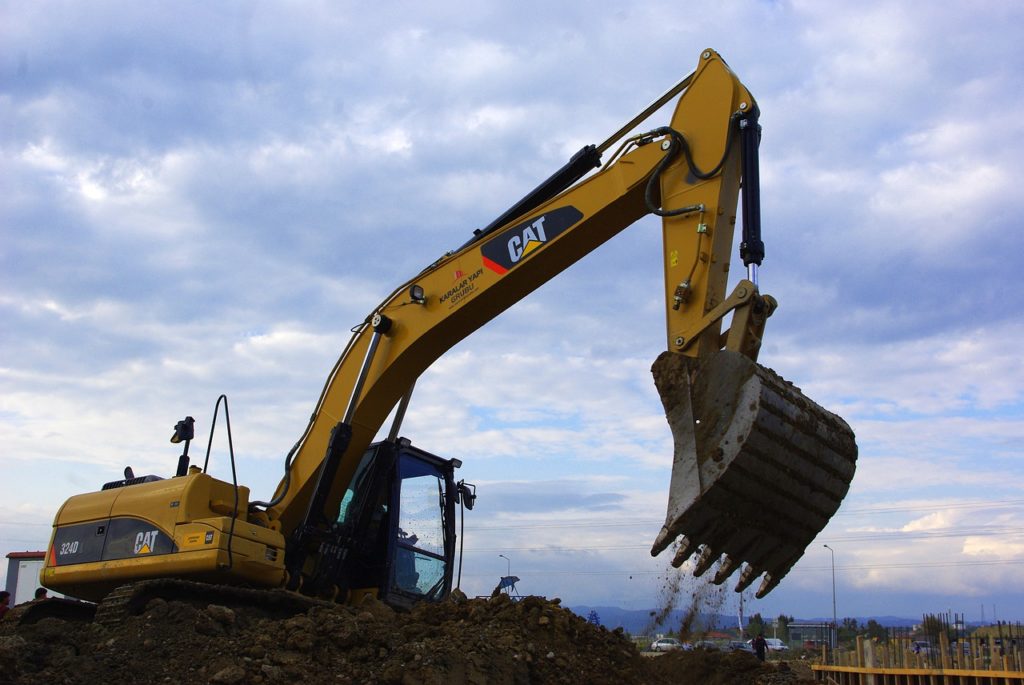
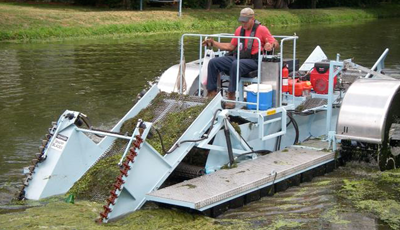
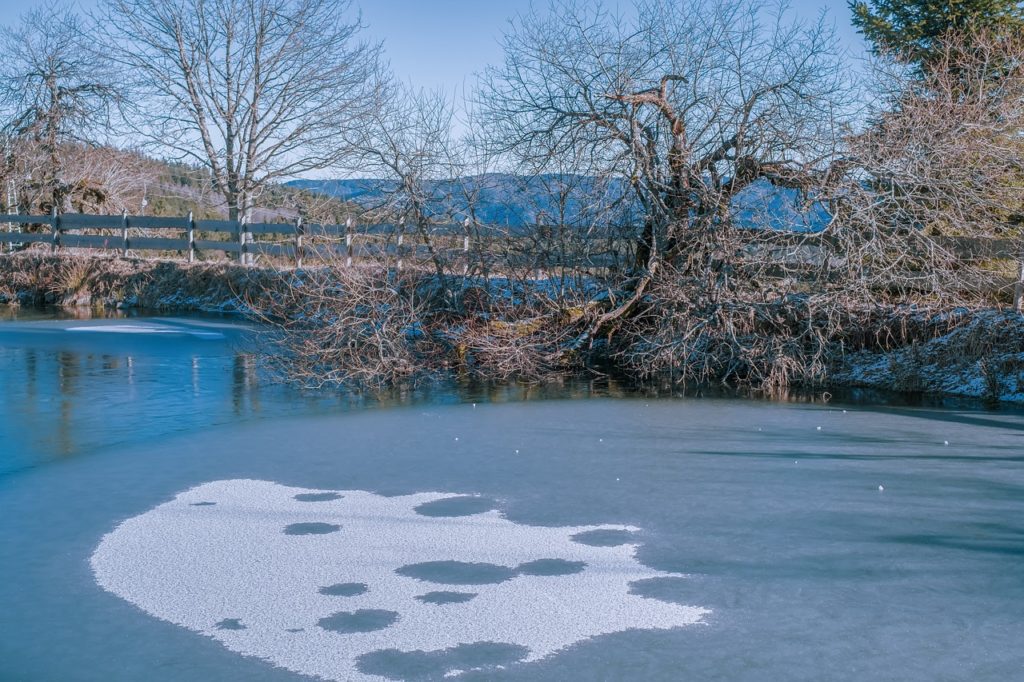
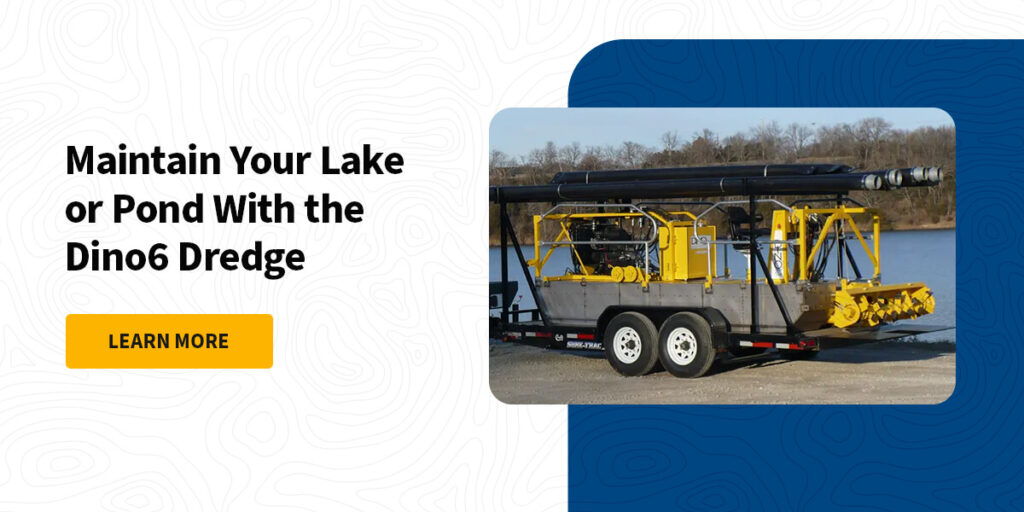
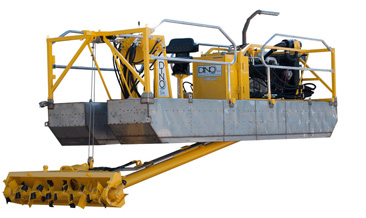 Dino6
Dino6 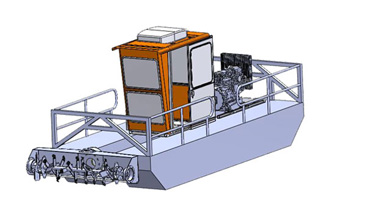 Dino8
Dino8 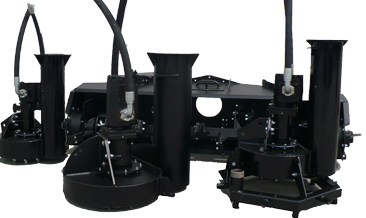 Submersible Pumps
Submersible Pumps